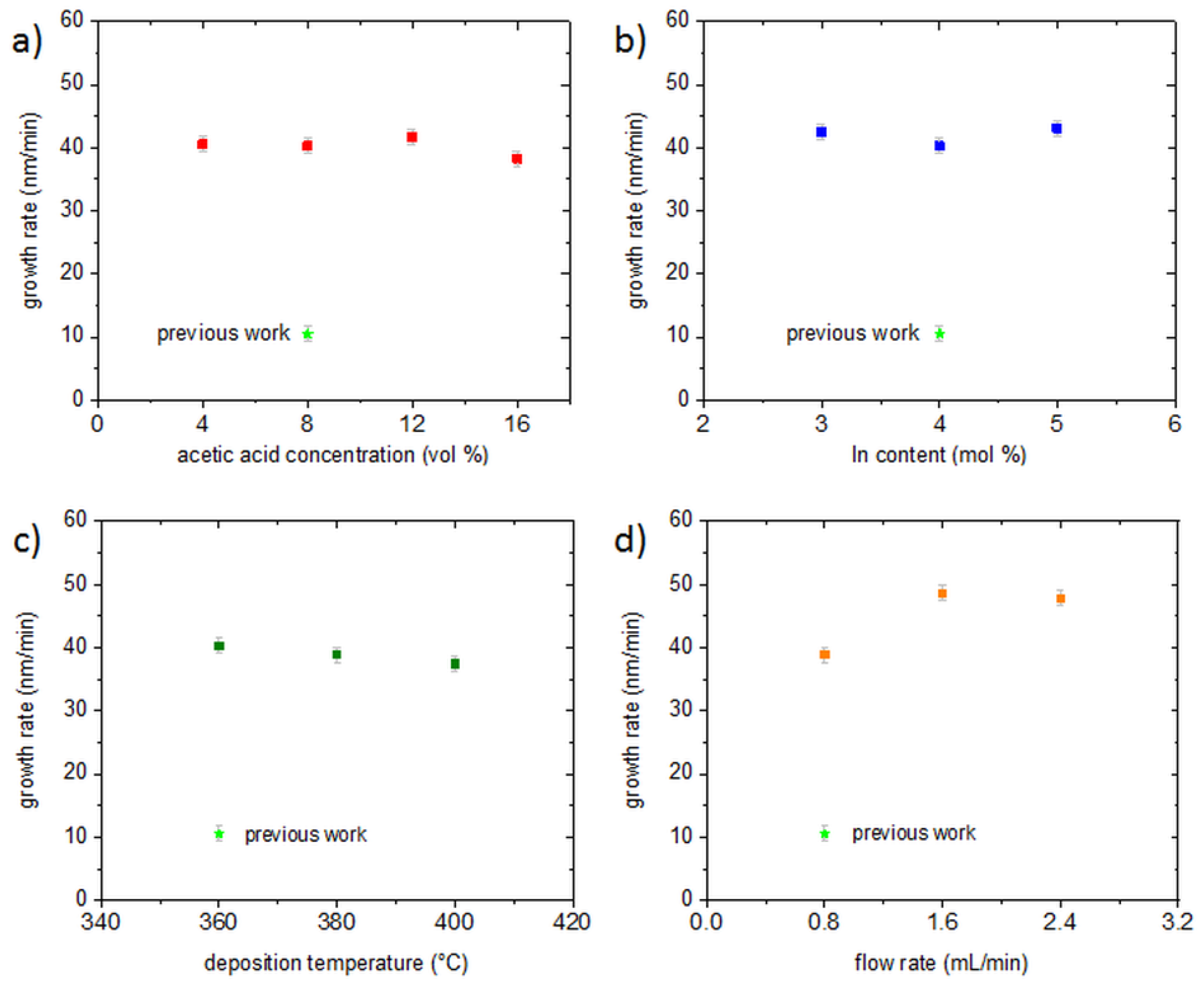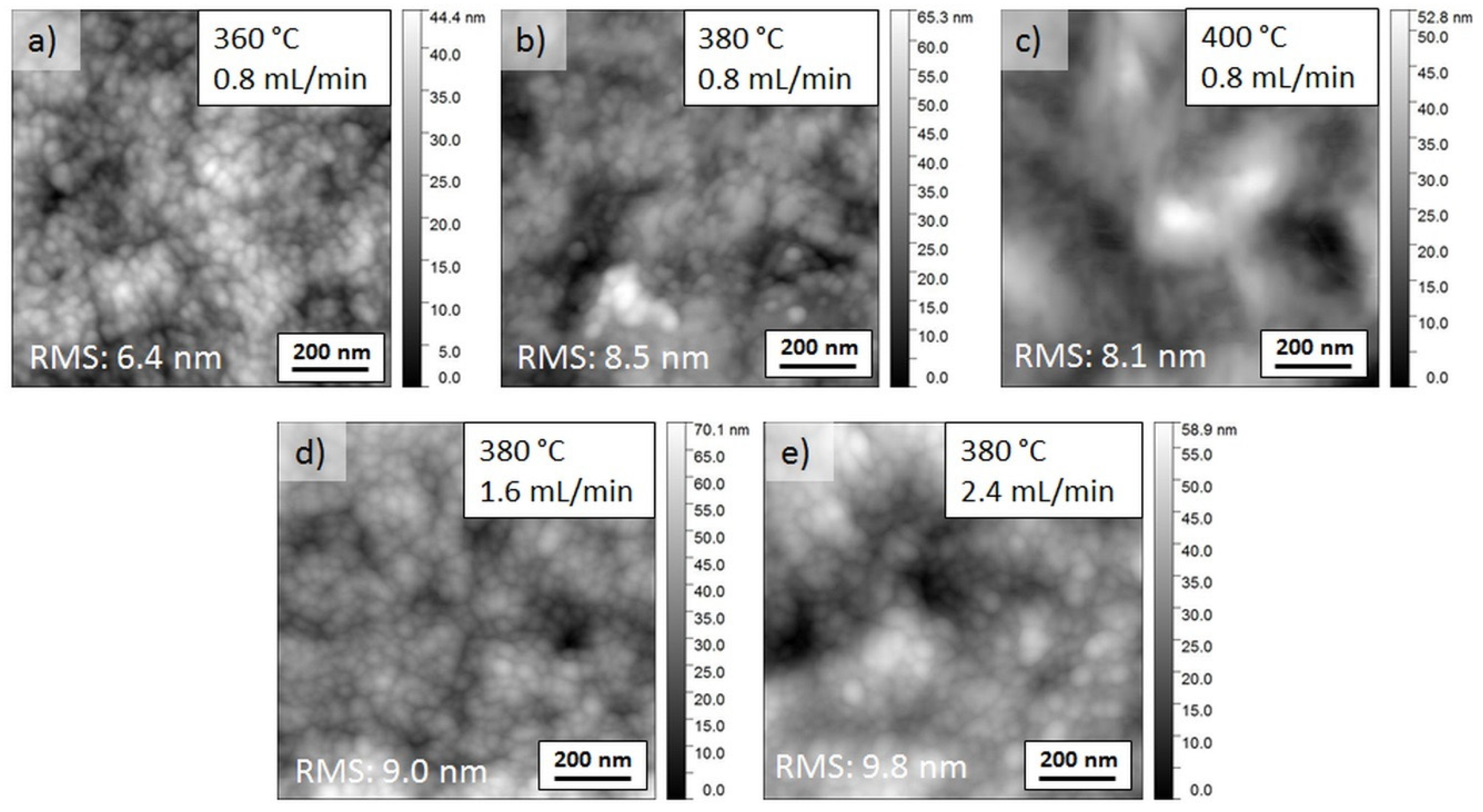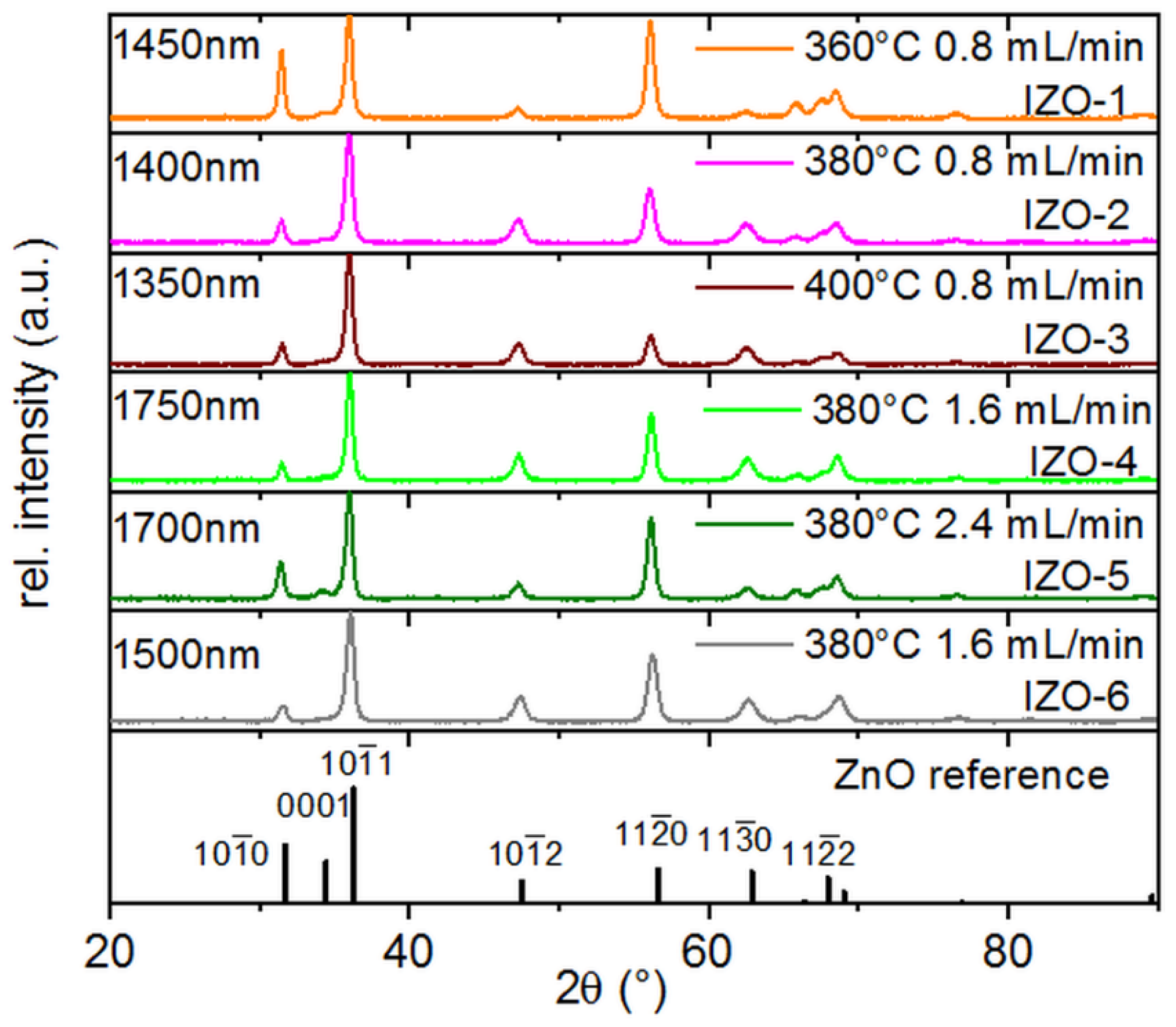Rapid Processing of In-Doped ZnO by Spray Pyrolysis from Environment-Friendly Precursor Solutions
Abstract
:1. Introduction
2. Materials and Methods
3. Results and Discussion
3.1. Film Growth Rate
3.2. Influence of Deposition Temperature and Solution Flow Rate on Film Properties
3.3. Optimized Spraying Pattern
4. Conclusions
Author Contributions
Funding
Acknowledgments
Conflicts of Interest
References
- Fortunato, E.; Barquinha, P.; Martins, R. Oxide semiconductor thin-film transistors: A review of recent advances. Adv. Mater. Weinheim 2012, 24, 2945–2986. [Google Scholar] [CrossRef]
- Granqvist, C.G. Transparent conductive electrodes for electrochromic devices: A review. Appl. Phys. A 1993, 57, 19–24. [Google Scholar] [CrossRef]
- Liu, H.; Avrutin, V.; Izyumskaya, N.; Özgür, Ü.; Morkoç, H. Transparent conducting oxides for electrode applications in light emitting and absorbing devices. Superlattices Microstruct. 2010, 48, 458–484. [Google Scholar] [CrossRef]
- Fortunato, E.; Ginley, D.; Hosono, H.; Paine, D.C. Transparent conducting oxides for photovoltaics. MRS Bull. 2007, 32, 242–247. [Google Scholar] [CrossRef]
- Nunes, P.; Fortunato, E.; Tonello, P.; Braz Fernandes, F.; Vilarinho, P.; Martins, R. Effect of different dopant elements on the properties of ZnO thin films. Vacuum 2002, 64, 281–285. [Google Scholar] [CrossRef]
- Gómez, H.; González, J.L.; Torres, G.A.; Maldonado, A.; Olvera, M.D.L.L. Doping effect on the physical properties of zinc oxide thin films. In Proceedings of the 2012 9th International Conference on Electrical Engineering, Computing Science and Automatic Control (CCE), Mexico City, Mexico, 26–28 September 2012; pp. 1–5. [Google Scholar]
- Maller, R.; Porte, Y.; Alshareef, H.N.; McLachlan, M.A. Probing the doping mechanisms and electrical properties of Al, Ga and in doped ZnO prepared by spray pyrolysis. J. Mater. Chem. C 2016, 4, 5953–5961. [Google Scholar] [CrossRef]
- Edinger, S.; Bansal, N.; Bauch, M.; Wibowo, R.A.; Újvári, G.; Hamid, R.; Trimmel, G.; Dimopoulos, T. Highly transparent and conductive indium-doped zinc oxide films deposited at low substrate temperature by spray pyrolysis from water-based solutions. J. Mater. Sci. 2017, 52, 8591–8602. [Google Scholar] [CrossRef]
- Castañeda, L.; García-Valenzuela, A.; Zironi, E.P.; Cañetas-Ortega, J.; Terrones, M.; Maldonado, A. Formation of indium-doped zinc oxide thin films using chemical spray techniques: The importance of acetic acid content in the aerosol solution and the substrate temperature for enhancing electrical transport. Thin Solid Films 2006, 503, 212–218. [Google Scholar] [CrossRef]
- Goyal, D.J.; Agashe, C.; Takwale, M.G.; Bhide, V.G.; Mahamuni, S.; Kulkarni, S.K. Dopant induced modifications in the physical properties of sprayed ZnO: In films. J. Mater. Res. 1993, 8, 1052–1056. [Google Scholar] [CrossRef]
- Biswal, R.; Maldonado, A.; Vega-Pérez, J.; Acosta, D.R.; Olvera, M.D.L.L. Indium Doped Zinc Oxide Thin Films Deposited by Ultrasonic Chemical Spray Technique, Starting from Zinc Acetylacetonate and Indium Chloride. Materials (Basel) 2014, 7, 5038–5046. [Google Scholar] [CrossRef] [Green Version]
- Sigma Aldrich Handels GmbH. Materials Safety Data Sheet: Indium(III)acetylacetonate; Sigma: Wien, Austria, 2017. [Google Scholar]
- Winkler, N.; Edinger, S.; Kaur, J.; Wibowo, R.A.; Kautek, W.; Dimopoulos, T. Solution-processed all-oxide solar cell based on electrodeposited Cu2O and ZnMgO by spray pyrolysis. J. Mater. Sci. 2018, 53, 12231–12243. [Google Scholar] [CrossRef]
- Khan, O.F.Z.; O’Brien, P. On the use of zinc acetate as a novel precursor for the deposition of ZnO by low-pressure metal-organic chemical vapour deposition. Thin Solid Films 1989, 173, 95–97. [Google Scholar] [CrossRef]
- Arca, E.; Fleischer, K.; Shvets, I.V. Influence of the Precursors and Chemical Composition of the Solution on the Properties of ZnO Thin Films Grown by Spray Pyrolysis. J. Phys. Chem. C 2009, 113, 21074–21081. [Google Scholar] [CrossRef] [Green Version]
- Perednis, D.; Gauckler, L.J. Thin Film Deposition Using Spray Pyrolysis. J. Electroceram. 2005, 14, 103–111. [Google Scholar] [CrossRef]
- Maldonado, A.; Asomoza, R.; Cañetas-Ortega, J.; Zironi, E.P.; Hernández, R.; Patiño, R.; Solorza-Feria, O. Effect of the pH on the physical properties of ZnO:In thin films deposited by spray pyrolysis. Solar Energy Mater. Solar Cells 1999, 57, 331–344. [Google Scholar] [CrossRef]
- Lehraki, N.; Aida, M.S.; Abed, S.; Attaf, N.; Attaf, A.; Poulain, M. ZnO thin films deposition by spray pyrolysis: Influence of precursor solution properties. Curr. Appl. Phys. 2012, 12, 1283–1287. [Google Scholar] [CrossRef]
- Caillaud, F.; Smith, A.; Baumard, J.-F. Effect of pH of the Solution on the Deposition of Zinc Oxide Films by Spray Pyrolysis. J. Am. Ceram. Soc. 1993, 76, 998–1002. [Google Scholar] [CrossRef]
- Castañeda, L.; Maldonado, A.; Escobedo-Morales, A.; Avendaño-Alejo, M.; Gómez, H.; Vega-Pérez, J.; Olvera, M.D.L.L. Indium doped zinc oxide thin films deposited by ultrasonic spray pyrolysis technique: Effect of the substrate temperature on the physical properties. Mater. Sci. Semicond. Process. 2011, 14, 114–119. [Google Scholar] [CrossRef]
- Vent, M.; Kärber, E.; Unt, T.; Mere, A.; Krunks, M. The effect of growth temperature and spraying rate on the properties of ZnO: In films. Phys. Status Solidi C 2012, 9, 1604–1606. [Google Scholar] [CrossRef]
- Rozati, S.M.; Zarenejad, F.; Memarian, N. Study on physical properties of indium-doped zinc oxide deposited by spray pyrolysis technique. Thin Solid Films 2011, 520, 1259–1262. [Google Scholar] [CrossRef]
- Tokumoto, M.S.; Smith, A.; Santilli, C.V.; Pulcinelli, S.H.; Craievich, A.F.; Elkaim, E.; Traverse, A.; Briois, V. Structural electrical and optical properties of undoped and indium doped ZnO thin films prepared by the pyrosol process at different temperatures. Thin Solid Films 2002, 416, 284–293. [Google Scholar] [CrossRef]
- Kriisa, M.; Krunks, M.; Kärber, E.; Kukk, M.; Mikli, V.; Mere, A. Effect of Solution Spray Rate on the Properties of Chemically Sprayed ZnO: In Thin Films. J. Nanomater. 2013, 2013, 423632. [Google Scholar] [CrossRef]
- Lucio-López, M.A.; Maldonado, A.; Castanedo-Pérez, R.; Torres-Delgado, G.; de la, L.; Olvera, M. Thickness dependence of ZnO: In thin films doped with different indium compounds and deposited by chemical spray. Solar Energy Mater. Solar Cells 2006, 90, 2362–2376. [Google Scholar] [CrossRef]
- Alamdari, S.; Tafreshi, M.J.; Ghamsari, M.S. The effects of indium precursors on the structural, optical and electrical properties of nanostructured thin ZnO films. Mater. Lett. 2017, 197, 94–97. [Google Scholar] [CrossRef]
- Biswal, R.; Castañeda, L.; Moctezuma, R.; Vega-Pérez, J.; Olvera, M.D.L.L.; Maldonado, A. Formation of indium-doped zinc oxide thin films using ultrasonic spray pyrolysis: The importance of the water content in the aerosol solution and the substrate temperature for enhancing electrical transport. Materials 2012, 5, 432–442. [Google Scholar] [CrossRef]
- Patterson, A.L. The Scherrer Formula for X-Ray Particle Size Determination. Phys. Rev. 1939, 56, 978–982. [Google Scholar] [CrossRef]
- Tauc, J. Optical properties and electronic structure of amorphous Ge and Si. Mater. Res. Bull. 1968, 3, 37–46. [Google Scholar] [CrossRef]
- Saw, K.G.; Aznan, N.M.; Yam, F.K.; Ng, S.S.; Pung, S.Y. New Insights on the Burstein-Moss Shift and Band Gap Narrowing in Indium-Doped Zinc Oxide Thin Films. PLoS ONE 2015, 10, e0141180. [Google Scholar] [CrossRef]







| Exp. No. | Temp. (°C) | Flow Rate (mL/min) | Spraying Cycles | Film Thickness (nm) | Growth Rate (nm/min) | Resistivity (Ω∙cm) | Sheet Resistance (Ω/sq) | Crystallite Size (nm) |
|---|---|---|---|---|---|---|---|---|
| IZO-1 | 360 | 0.8 | 540 | 1450 | 40.3 | 7.4 × 10−3 | 51 | 12.1 |
| IZO-2 | 380 | 0.8 | 540 | 1400 | 38.9 | 7.3 × 10−3 | 52 | 15.8 |
| IZO-3 | 400 | 0.8 | 540 | 1350 | 37.5 | 1.4 × 10−2 | 104 | 16.1 |
| IZO-4 | 380 | 1.6 | 270 | 1750 | 49.8 | 4.7 × 10−3 | 27 | 17.4 |
| IZO-5 | 380 | 2.4 | 180 | 1720 | 47.8 | 4.6 × 10−3 | 27 | 16.7 |
| IZO-6 | 380 | 1.6 | 200* | 1500 | 53.3 | 5.7 × 10−3 | 38 | 14.4 |
© 2019 by the authors. Licensee MDPI, Basel, Switzerland. This article is an open access article distributed under the terms and conditions of the Creative Commons Attribution (CC BY) license (http://creativecommons.org/licenses/by/4.0/).
Share and Cite
Winkler, N.; Wibowo, A.R.; Kubicek, B.; Kautek, W.; Ligorio, G.; List-Kratochvil, E.J.W.; Dimopoulos, T. Rapid Processing of In-Doped ZnO by Spray Pyrolysis from Environment-Friendly Precursor Solutions. Coatings 2019, 9, 245. https://doi.org/10.3390/coatings9040245
Winkler N, Wibowo AR, Kubicek B, Kautek W, Ligorio G, List-Kratochvil EJW, Dimopoulos T. Rapid Processing of In-Doped ZnO by Spray Pyrolysis from Environment-Friendly Precursor Solutions. Coatings. 2019; 9(4):245. https://doi.org/10.3390/coatings9040245
Chicago/Turabian StyleWinkler, Nina, Adhi Rachmat Wibowo, Bernhard Kubicek, Wolfgang Kautek, Giovanni Ligorio, Emil J. W. List-Kratochvil, and Theodoros Dimopoulos. 2019. "Rapid Processing of In-Doped ZnO by Spray Pyrolysis from Environment-Friendly Precursor Solutions" Coatings 9, no. 4: 245. https://doi.org/10.3390/coatings9040245





